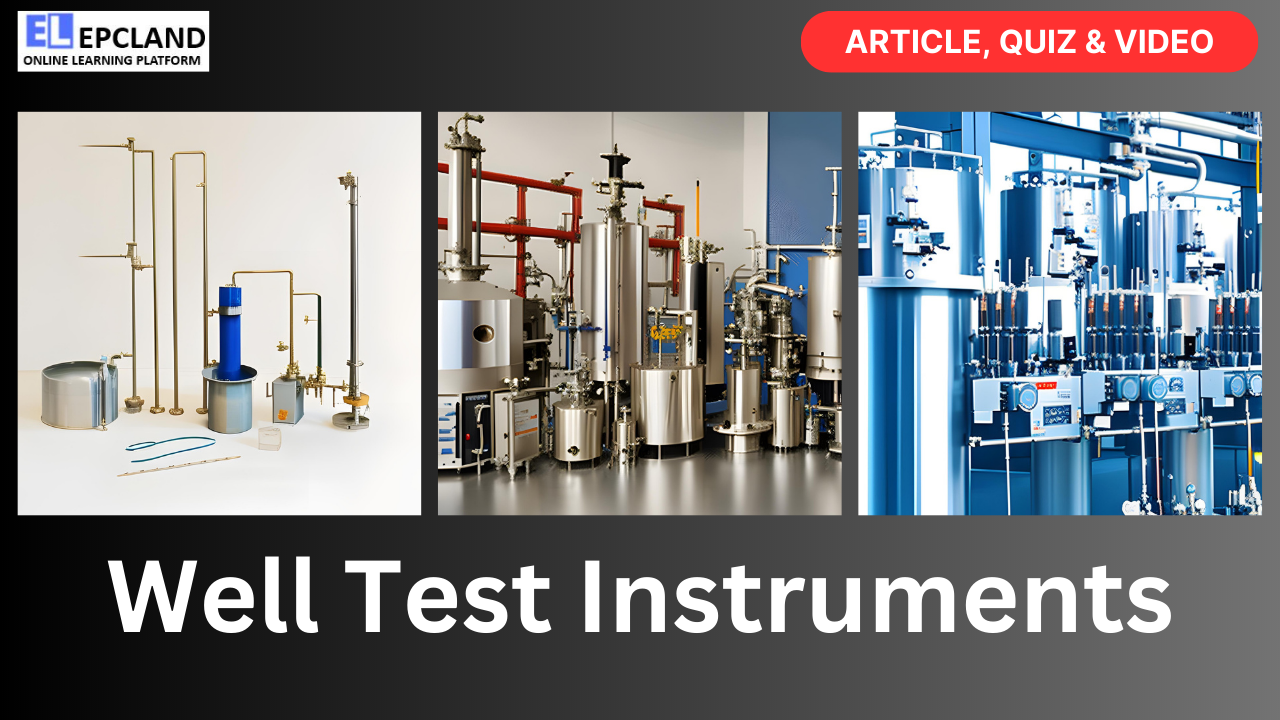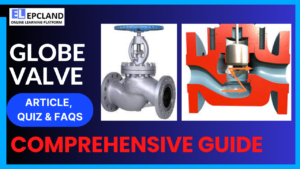In the world of oil and gas exploration and production, obtaining accurate data about reservoir properties is paramount. This data helps engineers and geologists make informed decisions about the viability and productivity of a well. Well test instruments play a pivotal role in this process, providing critical information about reservoir pressure, fluid properties, and overall reservoir performance. In this article, we will explore the various well test instruments used in the oil and gas industry, their functions, and their significance in ensuring successful project outcomes.
Table of Contents
Do not miss the detailed course 7 Modules of Piping Codes & Standards
Enrollment link
Introduction to Well Testing
Well testing is a crucial phase in the lifecycle of an oil or gas well. It involves the controlled production of fluids from a reservoir to the surface for analysis and evaluation. The primary objectives of well testing include:
- Reservoir Characterization: Well tests help determine reservoir parameters such as pressure, temperature, permeability, and fluid properties. This information is vital for reservoir modeling and management.
- Well Performance Evaluation: Well tests assess the productivity and deliverability of a well. Engineers can determine flow rates, identify restrictions, and optimize production strategies.
- Reservoir Connectivity: Testing multiple wells in an area can reveal how they are connected underground, aiding in reservoir management.
- Production Optimization: Understanding reservoir behavior through well testing helps optimize production rates and enhance oil and gas recovery.
Key Well Test Instruments
Well testing involves a range of specialized instruments designed to measure various parameters and gather essential data. Here are some of the key well test instruments used in the oil and gas industry:
1. Pressure Gauges
Pressure measurement is fundamental in well testing. Pressure gauges are deployed downhole to measure formation pressure, which is critical for reservoir characterization. There are various types of pressure gauges, including:
- Downhole Pressure Gauges: These gauges are placed downhole at specific depths to measure reservoir pressure in real time. They provide valuable insights into pressure changes during well testing.
- Surface Pressure Gauges: Surface pressure gauges monitor pressure at the wellhead during production. They help ensure safe and efficient operations.
2. Flow Meters
Flow meters are used to measure the rate of fluid production from a well. Accurate flow rate data is essential for assessing well performance. Common types of flow meters include:
- Turbine Flow Meters: These meters are often used for measuring gas flow rates. They rely on the rotation of a turbine within the fluid stream to calculate flow.
- Positive Displacement Meters: Positive displacement meters are used for measuring liquid flow rates. They work by trapping and measuring discrete volumes of fluid.
- Venturi Meters: Venturi meters are commonly used for gas flow measurement. They rely on the pressure drop across a constricted section of the flow path to calculate flow rate.
3. Fluid Sampling Tools
Fluid sampling is crucial for analyzing the composition of reservoir fluids. Specialized tools are used to collect samples of oil, gas, and water. These tools include:
- Downhole Sampling Tools: Downhole samplers are designed to capture fluid samples from specific depths within the reservoir. These samples provide valuable insights into fluid properties.
- Surface Sampling Equipment: Surface sampling equipment is used to collect samples of produced fluids at the wellhead. These samples can be analyzed for chemical composition and phase behavior.
4. Temperature Sensors
Temperature sensors are deployed downhole to measure reservoir temperature. Temperature data is essential for understanding fluid properties and the thermal behavior of the reservoir.
- Downhole Temperature Gauges: These sensors are placed downhole to record temperature profiles within the wellbore and reservoir.
- Surface Temperature Sensors: Surface temperature sensors monitor the temperature of fluids at the wellhead and are essential for managing thermal conditions during production.
5. Choke Valves
Choke valves are used to control the flow of fluids from the reservoir to the surface. They play a critical role in regulating flow rates and maintaining safe operating conditions.
- Adjustable Chokes: Adjustable choke valves allow operators to vary the flow restriction to achieve desired flow rates and pressures.
- Fixed Chokes: Fixed choke valves have a constant flow restriction and are often used in specific production scenarios.
Significance of Well Test Instruments
The use of well test instruments is not merely a formality in the oil and gas industry; it is a fundamental practice with significant implications for project success. Here are some key reasons why well test instruments are indispensable:
1. Reservoir Characterization
Well test instruments provide critical data for characterizing the reservoir. This includes information on reservoir pressure, temperature, permeability, and fluid properties. Accurate reservoir characterization is essential for estimating reserves and planning production strategies.
2. Production Optimization
By monitoring flow rates and pressure changes during well testing, engineers can optimize production rates and maximize oil and gas recovery. This leads to increased production efficiency and profitability.
3. Safety Assurance
Pressure gauges and flow meters play a vital role in ensuring the safety of well operations. Monitoring pressure levels and flow rates helps prevent accidents and equipment failures.
4. Environmental Compliance
Well test instruments aid in monitoring and controlling fluid emissions, ensuring compliance with environmental regulations. Accurate data allows operators to manage produced water and gas responsibly.
Types of Well Tests
Well testing is not a one-size-fits-all process; different types of tests are conducted to achieve specific objectives. Some common well test types include:
1. Reservoir Pressure Tests
Reservoir pressure tests, often referred to as pressure transient tests, are conducted to determine reservoir pressure and assess reservoir properties. The data obtained is crucial for reservoir modeling and development planning.
2. Productivity Tests
Productivity tests assess the flow rates and deliverability of a well. These tests help determine the well’s production potential and optimize production strategies.
3. Injectivity Tests
Injectivity tests are performed in injection wells to evaluate their capacity to accept fluids such as water or gas. This data is essential for enhanced oil recovery (EOR) and reservoir management.
4. Interference Tests
Interference tests involve testing multiple wells in an area simultaneously. By monitoring pressure changes in one well while another is produced or injected, engineers can assess reservoir connectivity.
5. Build-Up Tests
Build-up tests involve shutting in a well to allow pressure to build up in the reservoir. This data is used to estimate reservoir properties and assess the well’s deliverability.
Do not miss the detailed course 7 Modules of Piping Codes & Standards
Enrollment link
Case Studies: The Importance of Well Test Instruments
To illustrate the significance of well test instruments, let’s explore two case studies showcasing how these instruments played a crucial role in oil and gas projects.
Case Study 1: Reservoir Characterization
Objective: A petroleum company is planning to develop an offshore oilfield. They need to accurately characterize the reservoir to estimate reserves and plan production strategies.
Solution: The company conducts a series of pressure transient tests using downhole pressure gauges and temperature sensors. The data reveals critical reservoir properties, including pressure, temperature, and permeability. Fluid samples collected using downhole sampling tools provide information about fluid composition.
Outcome: With a detailed understanding of the reservoir, the company can confidently estimate reserves and plan production strategies. This leads to optimized well placement and drilling techniques, ultimately maximizing oil recovery.
Case Study 2: Well Productivity Enhancement
Objective: An operator is experiencing declining production from an existing well. They want to identify the cause of reduced productivity and implement measures to enhance flow rates.
Solution: Flow meters and pressure gauges are deployed to monitor the well’s performance. The data reveals that the well is experiencing increased flow restrictions due to scaling and sand production. Choke valves are adjusted based on real-time data to mitigate flow restrictions.
Outcome: By optimizing choke settings based on accurate flow rate and pressure data, the operator successfully enhances well productivity. This results in increased oil and gas production from the well.
Emerging Technologies in Well Testing
As technology advances, well test instruments continue to evolve, offering more precise data and enhanced capabilities. Some emerging technologies in well testing include:
1. Wireless Sensor Networks
Wireless sensor networks are becoming increasingly popular for downhole monitoring. These networks allow for real-time data transmission to the surface without the need for physical wires, reducing complexity and cost.
2. Fiber-Optic Sensing
Fiber-optic sensing technology provides high-resolution data for temperature and pressure monitoring along the entire wellbore. This technology offers improved accuracy and is especially valuable in unconventional reservoirs.
3. Artificial Intelligence and Data Analytics
Artificial intelligence and data analytics are being used to process and interpret vast amounts of well test data. These technologies can identify trends, anomalies, and optimization opportunities more efficiently than manual analysis.
Conclusion
Well test instruments are the eyes and ears of the oil and gas industry. They provide critical data that drives decision-making at every stage of a well’s life cycle, from reservoir characterization to production optimization. The significance of well test instruments cannot be overstated, as they ensure the safe and efficient extraction of valuable resources while minimizing environmental impact.
As technology continues to advance, the capabilities of well test instruments will only grow, allowing operators to extract hydrocarbons more efficiently and sustainably. Well testing is not just a technical necessity; it is a strategic imperative that enables the oil and gas industry to thrive in an ever-evolving energy landscape.
In conclusion, well test instruments are the unsung heroes of the oil and gas industry, quietly working beneath the surface to provide the data and insights needed to power the world.
FAQs
1. What is the purpose of well test instruments in the oil and gas industry?
- Well test instruments are used to measure critical parameters such as pressure, flow rates, and fluid properties during well testing. They provide essential data for reservoir characterization, production optimization, and safety assurance.
2. What types of instruments are commonly used in well testing?
- Common instruments used in well testing include pressure gauges, flow meters, fluid sampling tools, temperature sensors, and choke valves.
3. How do downhole pressure gauges work, and what is their significance in well testing?
- Downhole pressure gauges are deployed deep within the wellbore to measure formation pressure in real-time. They provide crucial data for reservoir characterization and assessing reservoir performance during production.
4. Why is flow rate measurement important in well testing?
- Flow rate measurement is essential for evaluating well performance, optimizing production rates, and maximizing oil and gas recovery. Accurate flow rate data helps in decision-making.
5. What role do fluid sampling tools play in well testing?
- Fluid sampling tools are used to collect samples of reservoir fluids, such as oil, gas, and water. These samples are analyzed to determine fluid properties, composition, and phase behavior.
6. How do temperature sensors contribute to well testing?
- Temperature sensors measure reservoir temperature, which is crucial for understanding fluid properties and the thermal behavior of the reservoir. Temperature data aids in reservoir modeling.
7. What is the significance of choke valves in well testing?
- Choke valves are used to control the flow of fluids from the well. They regulate flow rates, maintain safe operating conditions, and play a vital role in well testing operations.
8. What are some common types of well tests conducted in the oil and gas industry?
- Common well test types include reservoir pressure tests, productivity tests, injectivity tests, interference tests, and build-up tests. Each type serves specific objectives in reservoir evaluation.
9. How do wireless sensor networks impact well testing operations?
- Wireless sensor networks allow for real-time data transmission from downhole instruments to the surface without physical wires. They enhance data accessibility and reduce complexity in monitoring.
10. How are artificial intelligence and data analytics being used in well testing?
- Artificial intelligence and data analytics help process and interpret large volumes of well test data. These technologies can identify trends, anomalies, and optimization opportunities, improving decision-making in the industry.
Do not miss the detailed course 7 Modules of Piping Codes & Standards
Enrollment link
Recommended courses (Published on EPCLand)
- Basics of Piping Engineering
- Piping Layout Engineering
- Piping Material Engineering
- Piping Stress Analysis
- Complete Course on Piping Engineering
- Material Requisitions
- Piping Material Specifications
- Valve Material Specifications
Don’t miss the published articles on following:
Related Video
Attempt Quiz
Question 1:
Which instrument is commonly used to measure the flow rate of fluids in well testing?
Explanation: A flowmeter is commonly used to measure the flow rate of fluids in well testing.
Question 2:
Which instrument is used to monitor and record downhole pressure during well testing operations?
Explanation: Downhole pressure gauges are used to monitor and record downhole pressure during well testing operations.
Question 3:
Which instrument is employed to measure the temperature of well fluids in real-time during testing?
Explanation: Thermocouples are used to measure the temperature of well fluids in real-time during testing.
Question 4:
What instrument is essential for determining the oil, gas, and water composition in well fluids?
Explanation: A gas chromatograph is essential for determining the oil, gas, and water composition in well fluids.
Question 5:
Which instrument is used to measure the porosity and permeability of rock formations in a well?
Explanation: Petrophysical logging tools are used to measure the porosity and permeability of rock formations in a well.



